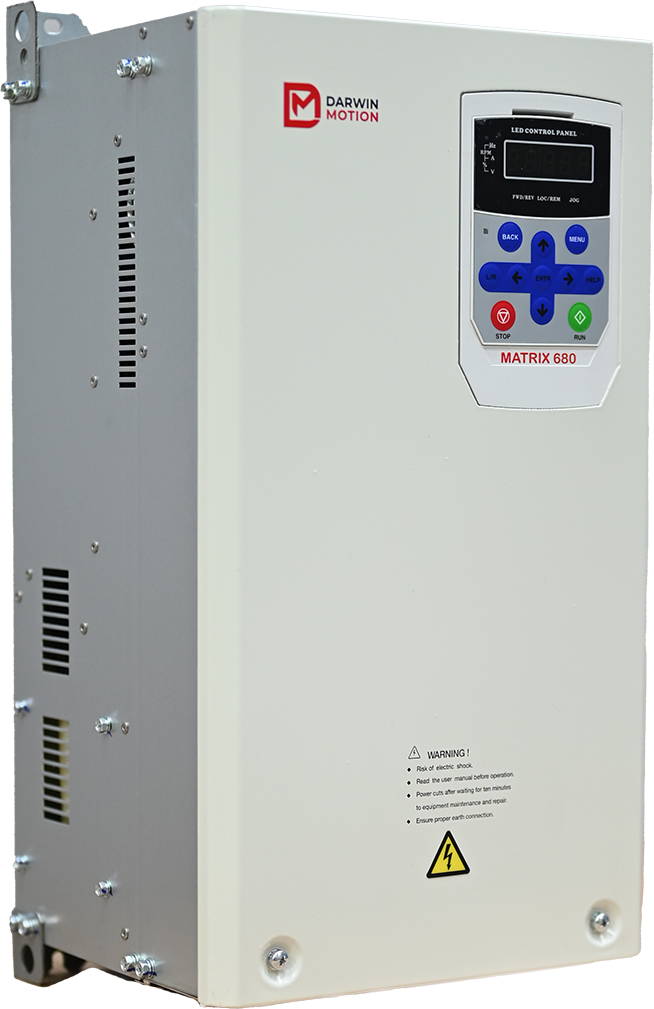Posted on 20th Nov 2024

Water treatment plants are crucial for ensuring that clean and safe water is available for consumption, agriculture, and industrial use. The operation of these plants involves a variety of complex processes, from filtration and chemical treatment to pumping and distribution. To achieve maximum efficiency and reliability in these processes, it's vital to integrate advanced technologies that enhance performance, reduce energy consumption, and ensure continuous operation. One such technology is the Darwin Motion Variable Frequency Drive (VFD).
A Variable Frequency Drive (VFD) is an electronic device used to control the speed and torque of an electric motor by varying the frequency of the power supplied to the motor. In the context of water treatment, VFDs are primarily used to control the speed of pumps, fans, and other motor-driven equipment.
Water treatment plants rely heavily on motors to power essential equipment such as pumps that move water through filtration systems, aeration tanks, and distribution networks. Traditional methods often involve running motors at full speed, consuming energy even when it’s not needed. A VFD, on the other hand, allows for precise control over motor speed, which directly impacts both energy efficiency and the longevity of the equipment.
The Darwin Motion VFD Drive offers a high level of reliability, ease of integration, and energy savings, making it an ideal choice for water treatment facilities that need to ensure trouble-free, 24/7 operation.
Water treatment processes are energy-intensive, particularly when it comes to pumping water through large systems. Darwin Motion VFD Drives help optimize energy usage by adjusting motor speeds based on demand. For example, during off-peak hours or when there is less water to pump, the VFD reduces the speed of the pump motors, lowering energy consumption. This helps water treatment plants cut down on energy costs, which is essential for large-scale operations.
Water treatment requires precise control over water flow, pressure, and other parameters to ensure that the treatment process is effective. The Darwin Motion high performance drive allows operators to fine-tune motor speeds for optimal control, ensuring that pumps, mixers, and other equipment perform efficiently according to the needs of the system.
This improved process control not only enhances the overall performance of the treatment plant but also ensures that water quality is consistently maintained, as flow rates and pressures are kept within the required ranges.
One of the most significant advantages of using a VFD is its ability to reduce mechanical stress on equipment. By gradually ramping up and ramping down motor speeds, Darwin Motion VFDs prevent the abrupt starts and stops that can cause excessive wear on motors and associated components, such as bearings and gears.
This smooth operation helps extend the life of critical equipment in water treatment facilities, reducing maintenance costs and downtime, which is especially important in mission-critical environments where equipment failure is costly.
Darwin Motion VFDs are designed for high reliability, even in demanding industrial environments. These drives are built with advanced fault protection features, such as overcurrent, under-voltage, and thermal protection, ensuring that the equipment continues to operate reliably and safely. This is particularly important in water treatment plants, where the continuous operation of pumps, compressors, and other systems is essential for ensuring the safety and quality of the water supply.
Moreover, the VFD's diagnostic features enable real-time monitoring and fault detection, allowing maintenance personnel to address issues before they cause significant downtime.
By reducing mechanical wear and offering advanced diagnostic features, Darwin Motion VFD Drives can significantly lower the maintenance requirements for motors and pumps in water treatment systems. With fewer breakdowns and a lower risk of component failure, maintenance costs can be reduced. Additionally, predictive maintenance features can help detect potential issues early, allowing for timely interventions before problems escalate.
The Darwin Motion VFD can be used in a wide range of applications within a water treatment plant. These include pump stations, aerators, chemical dosing systems, and other motor-driven equipment. The flexibility to adjust motor speeds according to the specific needs of each process area makes the VFD an indispensable tool for achieving operational efficiency across the entire plant.
By optimizing energy consumption and improving operational efficiency, the Darwin Motion VFD also contributes to a plant’s sustainability efforts. Reducing energy use not only lowers operational costs but also reduces the plant’s overall carbon footprint, aligning with global efforts to conserve energy and reduce environmental impact.
Incorporating the Darwin Motion VFD Drive into water treatment systems offers multiple advantages that lead to more efficient, reliable, and cost-effective operations. By providing precise control over motor speed, improving energy efficiency, and reducing wear on equipment, this technology ensures that water treatment plants can operate trouble-free around the clock.
Moreover, with its advanced protection features and ease of integration, the Darwin Motion VFD is a smart investment for plant managers looking to improve their operational reliability and reduce long-term maintenance costs.
For water treatment plants aiming to modernize their operations, the Darwin Motion VFD Drive offers a scalable solution that helps meet the demands of a growing population, increasing water demand, and environmental sustainability objectives.
In today’s fast-paced and energy-conscious world, the ability to operate water treatment plants efficiently while reducing downtime and costs is more important than ever. The Darwin Motion VFD Drive offers a state-of-the-art solution that helps achieve these goals by improving energy efficiency, reducing mechanical stress on equipment, and providing precise control over water treatment processes. With this technology, water treatment facilities can not only ensure consistent, trouble-free operation but also position themselves for long-term success in a competitive and environmentally conscious marketplace.